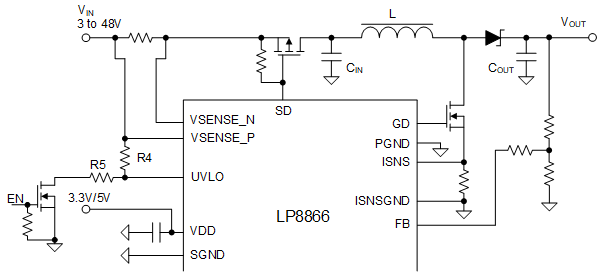SNVA966 July 2020 – MONTH LP8864-Q1 , LP8864S-Q1 , LP8866-Q1 , LP8866S-Q1
- Trademarks
- 1Fault Handling Routine
- 2Different Fault and Diagnostic Handling Method Recommendation
- 3Summary
-
A Fault-Related
Functions
-
A.1 Protection and Fault Detections
- A.1.1 Supply Faults
-
A.1.2 Boost Faults
- A.1.2.1 Boost Overvoltage Faults (BSTOVPL, BSTOVPH)
- A.1.2.2 Boost Overcurrent Faults (BSTOCP)
- A.1.2.3 LEDSET Resistor Missing Faults (LEDSET)
- A.1.2.4 MODE Resistor Missing Faults (MODESEL)
- A.1.2.5 FSET Resistor Missing Faults (FSET)
- A.1.2.6 ISET Resistor Out of Range Faults (ISET)
- A.1.2.7 Thermal Shutdown Faults (TSD)
- A.1.3 LED Faults
- A.1.4 Overview of the Fault and Protection Schemes
- A.2 Programming Examples
-
A.1 Protection and Fault Detections
The following equation is used to calculate the UVLO threshold for VIN rising edge:
Equation 1. 

where
- VINUVLO_TH = 0.787 V
The hysteresis of UVLO threshold can be designed and calculated with the following equation.
Equation 2. 

where
- IUVLO = 5 µA
So the following equation can be used for UVLO threshold for VIN falling edge:
Equation 3. 

The bottom resistors, R5 of voltage divider is able to be disconnected to the GND through an additional external N-type of FET as Figure 4-2. This design is to minimize the current leakage from VIN in shutdown mode to extend the battery life.
 Figure 4-2 VIN UVLO Setting Circuit Without Current Leakage Path
Figure 4-2 VIN UVLO Setting Circuit Without Current Leakage Path